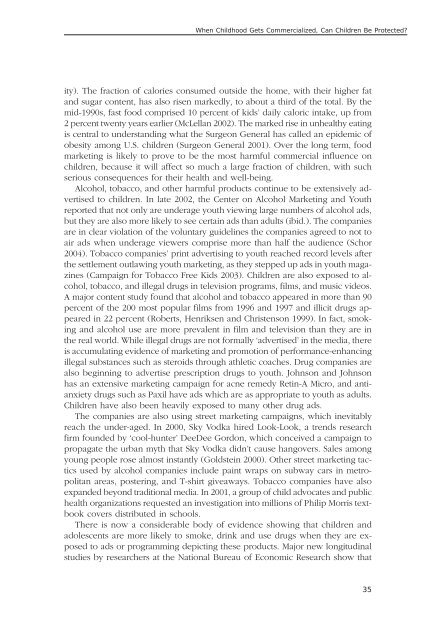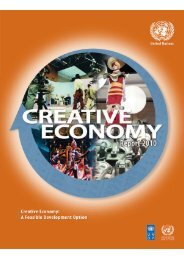In the Service of Young People? Studies and Reflections on Media ...
In the Service of Young People? Studies and Reflections on Media ...
In the Service of Young People? Studies and Reflections on Media ...
- No tags were found...
You also want an ePaper? Increase the reach of your titles
YUMPU automatically turns print PDFs into web optimized ePapers that Google loves.
When Childhood Gets Commercialized, Can Children Be Protected?ity). The fracti<strong>on</strong> <str<strong>on</strong>g>of</str<strong>on</strong>g> calories c<strong>on</strong>sumed outside <str<strong>on</strong>g>the</str<strong>on</strong>g> home, with <str<strong>on</strong>g>the</str<strong>on</strong>g>ir higher fat<str<strong>on</strong>g>and</str<strong>on</strong>g> sugar c<strong>on</strong>tent, has also risen markedly, to about a third <str<strong>on</strong>g>of</str<strong>on</strong>g> <str<strong>on</strong>g>the</str<strong>on</strong>g> total. By <str<strong>on</strong>g>the</str<strong>on</strong>g>mid-1990s, fast food comprised 10 percent <str<strong>on</strong>g>of</str<strong>on</strong>g> kids’ daily caloric intake, up from2 percent twenty years earlier (McLellan 2002). The marked rise in unhealthy eatingis central to underst<str<strong>on</strong>g>and</str<strong>on</strong>g>ing what <str<strong>on</strong>g>the</str<strong>on</strong>g> Surge<strong>on</strong> General has called an epidemic <str<strong>on</strong>g>of</str<strong>on</strong>g>obesity am<strong>on</strong>g U.S. children (Surge<strong>on</strong> General 2001). Over <str<strong>on</strong>g>the</str<strong>on</strong>g> l<strong>on</strong>g term, foodmarketing is likely to prove to be <str<strong>on</strong>g>the</str<strong>on</strong>g> most harmful commercial influence <strong>on</strong>children, because it will affect so much a large fracti<strong>on</strong> <str<strong>on</strong>g>of</str<strong>on</strong>g> children, with suchserious c<strong>on</strong>sequences for <str<strong>on</strong>g>the</str<strong>on</strong>g>ir health <str<strong>on</strong>g>and</str<strong>on</strong>g> well-being.Alcohol, tobacco, <str<strong>on</strong>g>and</str<strong>on</strong>g> o<str<strong>on</strong>g>the</str<strong>on</strong>g>r harmful products c<strong>on</strong>tinue to be extensively advertisedto children. <str<strong>on</strong>g>In</str<strong>on</strong>g> late 2002, <str<strong>on</strong>g>the</str<strong>on</strong>g> Center <strong>on</strong> Alcohol Marketing <str<strong>on</strong>g>and</str<strong>on</strong>g> Youthreported that not <strong>on</strong>ly are underage youth viewing large numbers <str<strong>on</strong>g>of</str<strong>on</strong>g> alcohol ads,but <str<strong>on</strong>g>the</str<strong>on</strong>g>y are also more likely to see certain ads than adults (ibid.). The companiesare in clear violati<strong>on</strong> <str<strong>on</strong>g>of</str<strong>on</strong>g> <str<strong>on</strong>g>the</str<strong>on</strong>g> voluntary guidelines <str<strong>on</strong>g>the</str<strong>on</strong>g> companies agreed to not toair ads when underage viewers comprise more than half <str<strong>on</strong>g>the</str<strong>on</strong>g> audience (Schor2004). Tobacco companies’ print advertising to youth reached record levels after<str<strong>on</strong>g>the</str<strong>on</strong>g> settlement outlawing youth marketing, as <str<strong>on</strong>g>the</str<strong>on</strong>g>y stepped up ads in youth magazines(Campaign for Tobacco Free Kids 2003). Children are also exposed to alcohol,tobacco, <str<strong>on</strong>g>and</str<strong>on</strong>g> illegal drugs in televisi<strong>on</strong> programs, films, <str<strong>on</strong>g>and</str<strong>on</strong>g> music videos.A major c<strong>on</strong>tent study found that alcohol <str<strong>on</strong>g>and</str<strong>on</strong>g> tobacco appeared in more than 90percent <str<strong>on</strong>g>of</str<strong>on</strong>g> <str<strong>on</strong>g>the</str<strong>on</strong>g> 200 most popular films from 1996 <str<strong>on</strong>g>and</str<strong>on</strong>g> 1997 <str<strong>on</strong>g>and</str<strong>on</strong>g> illicit drugs appearedin 22 percent (Roberts, Henriksen <str<strong>on</strong>g>and</str<strong>on</strong>g> Christens<strong>on</strong> 1999). <str<strong>on</strong>g>In</str<strong>on</strong>g> fact, smoking<str<strong>on</strong>g>and</str<strong>on</strong>g> alcohol use are more prevalent in film <str<strong>on</strong>g>and</str<strong>on</strong>g> televisi<strong>on</strong> than <str<strong>on</strong>g>the</str<strong>on</strong>g>y are in<str<strong>on</strong>g>the</str<strong>on</strong>g> real world. While illegal drugs are not formally ‘advertised’ in <str<strong>on</strong>g>the</str<strong>on</strong>g> media, <str<strong>on</strong>g>the</str<strong>on</strong>g>reis accumulating evidence <str<strong>on</strong>g>of</str<strong>on</strong>g> marketing <str<strong>on</strong>g>and</str<strong>on</strong>g> promoti<strong>on</strong> <str<strong>on</strong>g>of</str<strong>on</strong>g> performance-enhancingillegal substances such as steroids through athletic coaches. Drug companies arealso beginning to advertise prescripti<strong>on</strong> drugs to youth. Johns<strong>on</strong> <str<strong>on</strong>g>and</str<strong>on</strong>g> Johns<strong>on</strong>has an extensive marketing campaign for acne remedy Retin-A Micro, <str<strong>on</strong>g>and</str<strong>on</strong>g> antianxietydrugs such as Paxil have ads which are as appropriate to youth as adults.Children have also been heavily exposed to many o<str<strong>on</strong>g>the</str<strong>on</strong>g>r drug ads.The companies are also using street marketing campaigns, which inevitablyreach <str<strong>on</strong>g>the</str<strong>on</strong>g> under-aged. <str<strong>on</strong>g>In</str<strong>on</strong>g> 2000, Sky Vodka hired Look-Look, a trends researchfirm founded by ‘cool-hunter’ DeeDee Gord<strong>on</strong>, which c<strong>on</strong>ceived a campaign topropagate <str<strong>on</strong>g>the</str<strong>on</strong>g> urban myth that Sky Vodka didn’t cause hangovers. Sales am<strong>on</strong>gyoung people rose almost instantly (Goldstein 2000). O<str<strong>on</strong>g>the</str<strong>on</strong>g>r street marketing tacticsused by alcohol companies include paint wraps <strong>on</strong> subway cars in metropolitanareas, postering, <str<strong>on</strong>g>and</str<strong>on</strong>g> T-shirt giveaways. Tobacco companies have alsoexp<str<strong>on</strong>g>and</str<strong>on</strong>g>ed bey<strong>on</strong>d traditi<strong>on</strong>al media. <str<strong>on</strong>g>In</str<strong>on</strong>g> 2001, a group <str<strong>on</strong>g>of</str<strong>on</strong>g> child advocates <str<strong>on</strong>g>and</str<strong>on</strong>g> publichealth organizati<strong>on</strong>s requested an investigati<strong>on</strong> into milli<strong>on</strong>s <str<strong>on</strong>g>of</str<strong>on</strong>g> Philip Morris textbookcovers distributed in schools.There is now a c<strong>on</strong>siderable body <str<strong>on</strong>g>of</str<strong>on</strong>g> evidence showing that children <str<strong>on</strong>g>and</str<strong>on</strong>g>adolescents are more likely to smoke, drink <str<strong>on</strong>g>and</str<strong>on</strong>g> use drugs when <str<strong>on</strong>g>the</str<strong>on</strong>g>y are exposedto ads or programming depicting <str<strong>on</strong>g>the</str<strong>on</strong>g>se products. Major new l<strong>on</strong>gitudinalstudies by researchers at <str<strong>on</strong>g>the</str<strong>on</strong>g> Nati<strong>on</strong>al Bureau <str<strong>on</strong>g>of</str<strong>on</strong>g> Ec<strong>on</strong>omic Research show that35
















